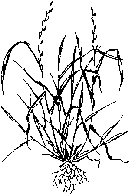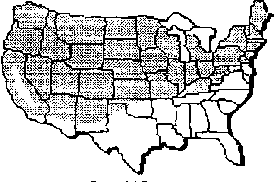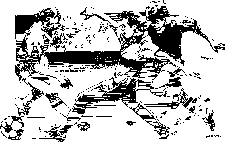The ryegrasses are widely distributed throughout the United States. In the South, annual ryegrass appears each fall from natural reseeding. In the transition zone, perennial ryegrass is used in mixtures with bluegrass for sports fields. Ryegrasses are widely used as a temporary turfgrass throughout the southern region for overseeding dormant warm season grasses.
Description. The ryegrasses (Lolium spp.) have a bunch-type growth habit and spread by profuse tillers. The tillers (stems) are erect and reach 1 to 2 feet in length. The leaves are rather succulent, dark green and glossy on the underside. The leaf sheath is about as long as the internode and auricles are clawlike, unusually clasping the sheath; the ligule is membranous.

The species is easily distinguished by the position of the multi-flowered spikelets, edgewise to the rachis, and the absence of the first glume except in the terminal spikelet. The infloresence is a long, slender spike (usually 4 to 6 inches long) with 15 to 30 solitary spikelets.
Mature ryegrass seed (florets) are 5 to 7 mm long, lanceolate and with or without awns. Italian ryegrass (L. multiflorum) is rarely awnless; perennial ryegrass (L. perenne) is awnless. Unlike most grasses, the rachilla segment on the basal floret is long and stout. Seeds of ryegrass are very similar to those of tall fescue. However, in ryegrass the rachilla segment has parallel sides and the apex is not expanded (knobbed). In tall fescue, the rachilla segment is tapered at the base and the apex is expanded into a disk, or knob.
The ryegrasses flower in early spring and seed mature in early summer. The annual species is a profilic seed producer. Natural reseedings develop each fall where the grass is managed to produce seed. It is common on roadsides each fall and winter from Texas to Florida.
 Adaptation and Use. The ryegrasses are best adapted to moist, cool
environments where temperatures are not extreme in the winter or summer.
Many European countries have climates ideally suited to the ryegrasses.
In the United States, the northeastern and northwestern states are well
suited to ryegrass. In the transition zone, perennial ryegrass may provide
a permanent turfgrass. But in the southern states, both species serve as
cool season annuals.
Adaptation and Use. The ryegrasses are best adapted to moist, cool
environments where temperatures are not extreme in the winter or summer.
Many European countries have climates ideally suited to the ryegrasses.
In the United States, the northeastern and northwestern states are well
suited to ryegrass. In the transition zone, perennial ryegrass may provide
a permanent turfgrass. But in the southern states, both species serve as
cool season annuals.The perennial species, L. perenne, is more cold tolerant than Italian ryegrass. However, both species are killed by extreme winter temperatures.
Ryegrasses are adapted to a wide range of soil conditions, but favor moist, well drained, fertile soils. The ryegrasses possess little drought tolerance and must be irrigated during dry periods to ensure survival. Shade tolerance of the ryegrasses is good in southern climates where shade conditions eliminate the extreme heat during summer. Perennial ryegrass often survives the hot, dry summers of the South in moderately shaded sites.
Both species of ryegrass are used for temporary grass cover during the fall and winter months in the South. Their quick establishment from seed (rapid germination and rapid seedling growth) makes them ideal for protection against erosion on newly prepared sites in the fall. They are also used to provide temporary green color during winter months when bermudagrass is dormant.
The ryegrasses have become very popular for overseeding athletic fields, golf courses and lawns during winter months. The improved turf-type perennial ryegrasses have greater cold tolerance, wear tolerance, disease resistance and persistence than the older types. New varieties also have better turf characteristics - finer texture, greater density, darker color and better mowing qualities.
In the transition zone, perennial ryegrasses may be used as permanent turfgrasses on golf courses, athletic fields and, in mixtures with bluegrass, on lawns.
Varieties. At lease 50 improved ryegrass varieties have been developed over the past 20 years. Most improvements have been in perennial ryegrass although intermediate crosses have been made with Italian ryegrass. Improvements in turf quality have been in the area of density, texture and color (Pennfine, Manhatten and Derby); mowing quality (Palmer, Manhattan II, Delray and Loretta); heat tolerance (Derby, Birdie, Palmer, Citation and Dasher); cold tolerance (Eton, Goalie, NK-200 and Norlea); disease resistance (Manhattan II, Palmer, Prelude and Delray); insect resistance (Repell); and drought tolerance (Palmer and Prelude).
Propagation. In California and many states where bluegrass is common, ryegrass is often established from sod in mixtures with bluegrass. In the southern states ryegrasses are established from seed. Ryegrasses are noted for their fast establishment rate and are primarily used for temporary cover in the South. Although ryegrass establishes quickly, it spreads slowly. Thus, relatively high seeding rates are used for turf. On golf courses and athletic fields where a fast, uniform cover is required, seeding rates of 25 to 40 pounds of ryegrass seed per 1,000 sq. ft. are commonly used. At these seeding rates a complete turf cover can be expected in 20 days.

On bermudagrass lawns where color is more important than density, ryegrass may be seeded at 5 to 7 pounds per 1,000 sq. ft. In these overseeding situations, ryegrass seed are broadcast over the surface of a closely mowed bermudagrass turf.
Seeding dates are very important when overseeding a bermudagrass turf. If overseeding is done too early, bermudagrass competes with the ryegrass seedlings and establishment may be poor. If overseeding is delayed, then cold temperatures may delay germination. The recommended seeding date is 2 to 4 weeks before the average first frost date.
In prepared seedbeds, ryegrass can be planted 10 to 12 weeks before the average first frost date and seeding rates can be reduced in prepared seedbeds to 3 to 5 lbs. per 1,000 sq. ft. Keep the seedbed moist for 10-14 days after planting to obtain maximum germination. After 2 weeks reduce watering frequency to an as needed basis.
To promote seedling growth, fertilize the seedbed prior to planting and at 3 week intervals after planting. Use a starter fertilizer prior to planting at a rate of 0.5 lb. of nitrogen per 1,000 sq. ft. Follow up with soluble nitrogen fertilizers applied at 3 week intervals at 0.5 lb. nitrogen per 1,000 sq. ft. until the desired cover develops.
Use fungicide-treated seed to control seedling diseases such as damping-off caused by Pythium. To provide additional protection during the seedling stage apply broad spectrum fungicides at 7 to 10 day intervals after planting.
Management. Of all turfgrasses used in the South, ryegrass probably has the highest maintenance requirement. Mowing, watering, fertilization and pest management needs of ryegrass are higher than for any southern turfgrass. Ryegrass has a rapid growth rate in the spring and requires twice weekly mowing at the taller heights - above 1 inch; mowing at 2 to 3 day intervals at heights between ° and 1 inch and daily mowing at heights below ° inch.
Ryegrass is the least drought tolerant of the southern turfgrasses and needs frequent watering in the spring and early summer. In many golf course situations, daily watering is not unusual on ryegrass greens and fairways. Even on lawns, ryegrass is the first grass to show symptoms of drought stress.
The nitrogen requirement of ryegrass is relatively high during the growing season - about 0.5 lb. per 1,000 sq. ft. per month from February through May. On golf greens mowed daily with clippings removed, about 1 pound of nitrogen per month is needed in the spring. On alkaline soils where iron might be limited, monthly applications of iron greatly improve the color of ryegrass.
Insects and diseases are serious pests to ryegrass. In the fall, during establishment of ryegrass, seedling diseases caused by Pythium, Rhizoctonia and Fusarium are problems. Leaf spot, dollar spot and rust are potential problems in the spring. Regular preventive applications of fungicides are needed on quality ryegrass turf such as found on golf courses and athletic fields.
Insects, particularly sod webworms and cutworms, are a nuisance on ryegrass. The dark green color of the grass attracts the moths that lay the eggs of these insects. Often, several applications of insecticide or biological worm control are needed during the spring and fall to control these insects on ryegrass.